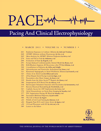Straight Screw-In Atrial Leads “J-Post Shaped” in Right Appendage Versus J-Shaped Systems for Permanent Atrial Pacing: A Safety Comparison
Abstract
Background and Objectives: The reliability of active-fixation atrial leads has been compared with that of passive-fixation leads; comparisons have also been made between straight and J-shaped screw-in lead systems. However, few data are available on procedural and short-term safety. This retrospective study compared the procedural safety of non-pre-shaped screw-in leads with that of passive- and active-fixation J-shaped leads.
Patients and Methods: From January 2004 to January 2010, 1,464 patients underwent new pacemaker/implantable cardioverter-defibrillator implantation. Of these, 915 (study population) received a passive- or active-fixation pre-J-shaped lead, or a straight screw-in atrial lead; the remaining 549 patients, who received only a ventricular lead, were excluded. The three study groups were: Group S-FIX (165 patients, 18%), receiving a straight screw-in atrial lead (postshaped in the right appendage); Group J-PASS (690 patients, 75.4%), receiving a passive-fixation J-shaped atrial lead; and Group J-FIX (60 patients, 6.6%), receiving an active-fixation screw-in J-shaped atrial lead.
Procedural and short-term complication rates were analyzed up to 3 months postimplantation.
Results: One complication occurred in each group (S-FIX 0.6% vs J-PASS 0.1% vs J-FIX 1.6%, P = 0.3, 0.1, and 0.4, respectively, for each comparison). The rate of atrial lead dislodgement was higher in Group J-PASS than in S-FIX but not J-FIX (Group S-FIX 0 vs Group J-PASS 16 vs Group J-FIX 1 dislodgements; P = 0.04 and 0.7, respectively).
Conclusion: Straight screw-in atrial leads, “J-post shaped” in the right appendage, offer better stability than passive-fixation J-shaped leads and display a similarly acceptable safety profile compared with both the J-shaped systems. (PACE 2011; 34:325–330)




